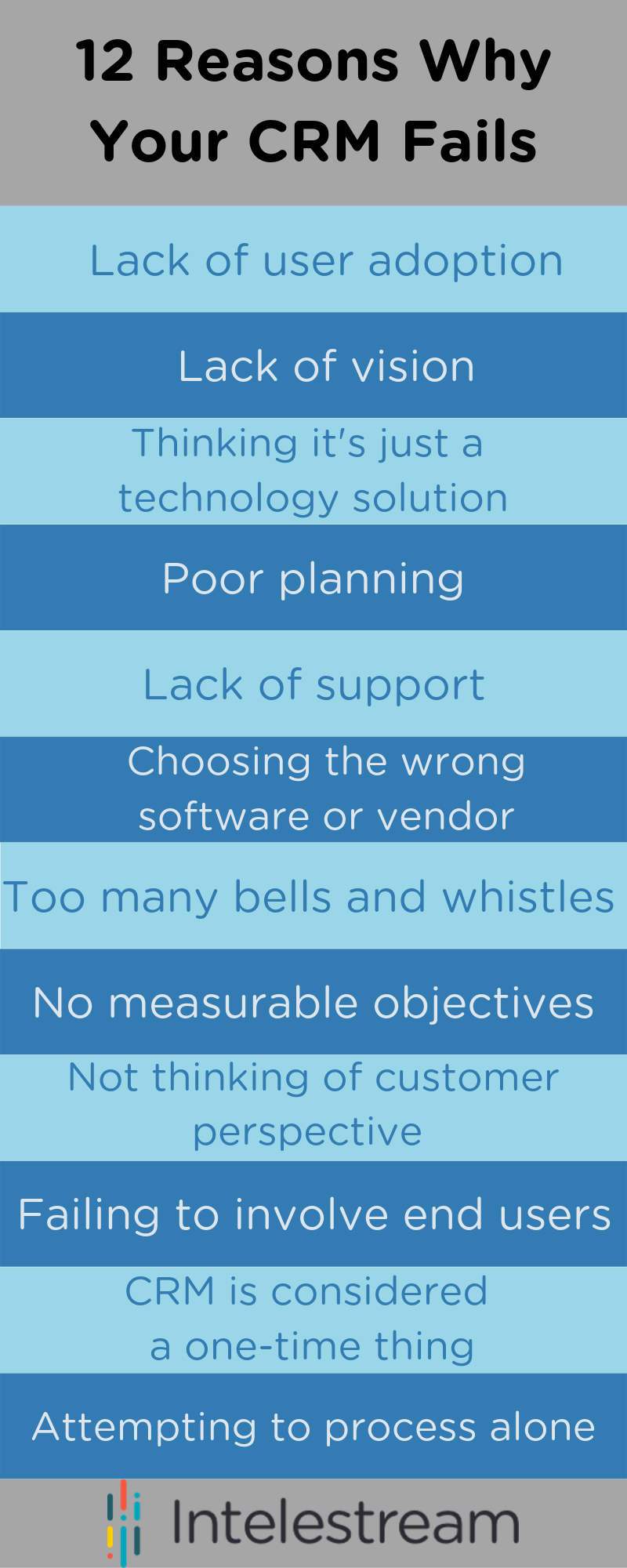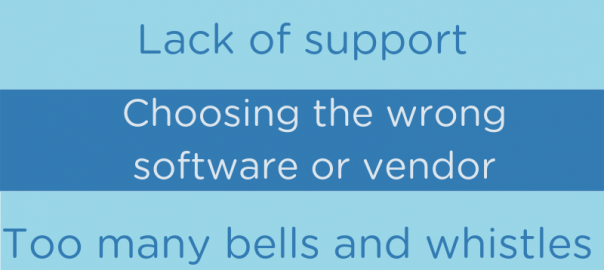Few things are as frustrating as going through the expensive, time-consuming process of implementing a new customer relationship management (CRM) system, only to see it fail. It’s an all-too-common problem, with multiple industry studies claiming failure rates between 47% and 63% for new CRMs. To avoid this costly situation, it’s important to understand how and why a CRM fails. If identified early, most of these issues can be corrected long before they threaten the entire CRM project.
Let’s take a look at the 12 most common reasons that a CRM fails, and how to fix them.
-
Lack of user adoption
Low user-adoption rates are the root cause of most customer relationship management (CRM) project failures. This happens when your employees and other CRM users actively resist learning essentials of the system. Perhaps the CRM isn’t well integrated with existing workflows and processes, or the system is just more confusing than it needs to be. This situation can often be avoided by bringing end users into the design and user-experience testing processes, and by enhancing CRM training.
-
Lack of vision
One of the biggest mistakes companies make going into a CRM project is not setting specific goals and targets. CRM software is designed to be flexible and adaptable, allowing it to be used in a wide range of industries and use cases. Without a clear vision of what you need your CRM to accomplish, it can be easy to lose focus over the planning and implementation process. The more specific your plans are for what the CRM — including how employees will use it in their daily work, and how it will improve your KPIs — the more likely it is that the implementation will be a success.
-
Thinking it’s just a technology solution
It’s easy for companies to get excited about the technology behind their CRM projects, but it’s important to remember that these software solutions should always be in service of enhancing customer relationships. The technology alone can’t improve those relationships. When the CRM’s technology is combined with the right workflows, operated by well-trained staff, and managed thoughtfully, the system’s full potential can be tapped into to generate powerful results.
-
Poor planning
Implementing a CRM system is not a simple task. It’s a multi-stage process, refining a general outline into clear workflows, software systems, data curation, user testing, and employee training. It’s not a process that benefits from trying to figure it out on the fly. Every moment invested in planning serves to prevent later confusion and frustration, ultimately helping to prevent a CRM failure.
-
Lack of support
In an ideal world, your CRM project would have a “champion” on staff to act as a software guru, cheerleader, and point person. If you don’t have a CRM champion, however, it’s absolutely vital to get a high level of support from your CRM vendor. Your team will always have questions about the system, and your software will inevitably need revisions and tweaks as your business grows and changes.
But it’s not just vendor support that’s needed. You also need buy-in from both executives and users. In order for your CRM system to have its best success, everyone involved with the process needs to be on board. It’s not enough for the C-Suite planners to acquiesce to trying out a CRM, they need to be 100% behind it. The better their understanding of the value the CRM brings to the company, the more invested they will become in its long-term success.
-
Choosing the wrong software or vendor
Choosing the right partner is important to your success, but so is selecting the right software. It can be tempting to choose the cheapest CRM software licenses, for instance, until you realize that customizing it to fit your company’s needs is often far more expensive than just buying the right software in first place. Other companies will make the opposite mistake, spending a small fortune on an expensive system with a ton of features that they will never use. Cost is important, but it should be a secondary consideration to finding the right CRM software for your company’s needs.
Can your CRM fail simply because you chose the wrong partners? Yes! Some vendors take a cookie-cutter approach to their work, delivering a bare-bones CRM that isn’t customized to the client’s unique needs. If a conflict arises between their client’s business processes and their one-size-fits-all software, they prefer to change the business rather than modify their own code. A true CRM partner will always build a customized solution that fits your needs.
-
Too many bells and whistles
CRM software is designed with customization mind, with dozens of modules and add-ons that can be configured to work for countless possible use cases. Unfortunately, some companies make the mistake of trying to make use of all of those options at once, rather than only using those that are essential for their specific needs. A great CRM provides a lean user experience, only making use of those elements which are absolutely necessary. Why force your teams to learn systems they will never use, or add additional steps to a process that should be simple? The more intuitive and streamlined the user experience, the better the user adoption rate.
-
No measurable objectives
How would know if you have implemented a well-designed CRM solution? If it was failing, how would you detect it? Without the right metrics, there’s really no way to tell if the CRM is a success. Your CRM project needs clear, measurable objectives that can be easily tracked, analyzed, and evaluated. This allows you to make timely changes to the CRM itself, workflows, and even training long before the CRM is at risk of failure.
-
Not thinking of customer perspective
The fundamental job of a CRM is to efficiently assemble customer information in one central location, and to make it easily accessible when needed. There are countless ways to organize this system, and typically this data is organized in the way that is easiest for the company, rather than the customer. In some cases — such as customer support — this company-centric approach isn’t always the optimal one. If your CRM is failing, it’s worth taking a step back to see how your customers (usually through your employees) interact with your CRM. You may find some surprising disconnects, roadblocks, and other frustrations that are only obvious when you work backwards from the customer’s experience.
-
Failing to involve end users
Design your CRM around the needs of the people who will use it most. A workflow that makes sense to a CRM vendor’s coder or UX designer might be bafflingly unintuitive or painfully slow to the salesperson, support desk agent, or data entry worker who has to use that system all day, every day. These end users are often the very people who ultimately determine if a CRM project succeeds or fails. If the system is poorly designed and implemented, those users will either avoid using it, or — even worse — use it in a way that makes the process less efficient than not having a CRM in the first place. By bringing these end users into the planning and user-testing stages, these headaches and costs can often be avoided completely.
-
CRM is considered a one-time thing
A CRM system should ebb and flow with your business. A great CRM isn’t the result of a single, perfectly executed implementation. Instead, ongoing refinements, revisions, and expansions lead to success. The CRM is never “perfect” because your business is always changing. If your CRM is failing, it might need an update so it has room to grow. At the same time, a great implementation partner won’t abandon the project when the CRM is finally up and running. Instead, they will check in with you regularly, providing the ideas and support you need to keep the CRM healthy.
-
Attempting the process alone
A CRM system can catapult your company’s efficiency if you implement it properly. The best way to do that is to partner with a customer relationship management software expert to ensure you are engaging your employees and getting the most from your investment.

Originally published here.
Business & Finance Articles on Business 2 Community
(54)
Report Post








